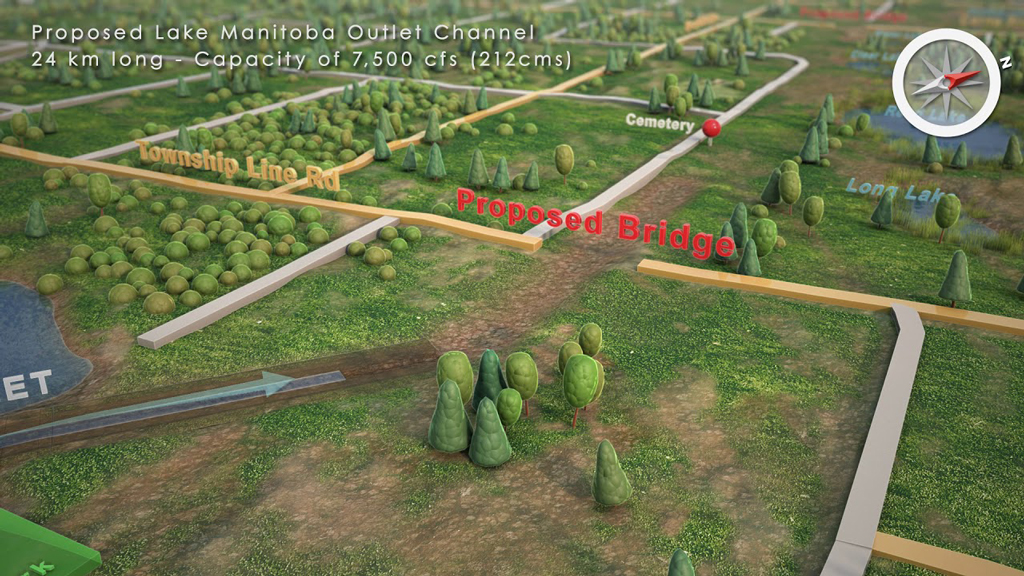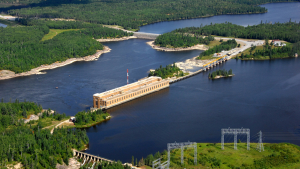Heavy equipment contractors in Manitoba are gearing up for major construction projects to be tendered for the $540-million Lake Manitoba-Lake St. Martin outlet channels project, which will be the largest earthmoving venture ever undertaken in the province since the expansion of the Red River Floodway.
The industry had hoped for construction to begin by fall but the project is still awaiting approval from environmental regulators in Ottawa who have questioned whether community concerns have been addressed.
A spokesperson for Manitoba Infrastructure (MI) says the project is currently in phase two of its four-phase Indigenous consultation and engagement process, with federal environmental licensing activities ongoing.
The project team met recently with the Manitoba Heavy Construction Association (MHCA) and Winnipeg Construction Association to discuss the proposed construction sequencing and tendering strategy.
“Manitoba is prepared to start construction upon receipt of environmental licences and will advertise the first construction packages accordingly,” the spokesperson said in a statement prepared for the Journal of Commerce. “The timing of advertisement is dependant on receipt of environmental licences.”
Construction contracts will be advertised in a sequenced approach once the federal government gives the greenlight to the project. The work will take place over a four-year period and involves tree clearing, excavation, blasting, construction of bridges, water control structures and the realignment of roads.
Construction on an access road started in September and the work is expected to continue until early in the new year.
The project consists of building two diversion channels, each roughly 24 kilometres long. The Lake Manitoba Outlet Channel will connect Watchorn Bay on Lake Manitoba to Birch Bay on Lake St. Martin and includes a water control structure and three bridges and realignment of municipal roads. The Lake St. Martin Outlet Channel will run from the east end of Lake St. Martin to Sturgeon Bay in Lake Winnipeg. It also includes a water control structure, several drop structures and a hydro distribution line.
The project is aimed at preventing a repeat of extensive flooding that forced thousands from their homes in First Nations communities in 2011. The planned completion date for the project is December 2025.
The two channels will enable the province to regulate water levels on the two lakes. The area is prone to flooding because of its typography and location, with water moving from the Rocky Mountains in the northern United States and boreal forests through northern Manitoba on the way to Hudson Bay.
“The enormity of the damage and disruption caused by the 2011 and 2014 flood events highlighted the need for improved flood protection on Lake Manitoba and Lake St. Martin, and led to the proposed project,” says the MI spokesperson. “The outlet channels project will create improved and permanent flood protection for Lake Manitoba and Lake St. Martin, providing resiliency as our climate changes.”
An estimated 600 to 900 construction workers will be involved throughout the construction period.
MHCA president Chris Lorenc says contractors are looking forward to getting the long-awaited project underway.
“We’re hoping that early in the new year, February, March, the approvals materialize and the tenders can start in the spring of 2022.”
The project is working towards completion of the final construction sequencing design and environmental licence approval sign-off by the federal government, says Lorenc.
“We met with them last week and had very good discussions with Manitoba Infrastructure, so we’re pleased that they are accommodating some of our requests and now it’s up to the province and the federal government to come to terms on environmental licences requirements.”
Lorenc says he’s optimistic the federal government will be reasonable and practical in its approach to signing off on environmental requirements, so that the work can begin.
Heavy equipment operators will move somewhere in the order of 25 million cubic metres of earth during the life of the project, he says.
“It’s a huge project and it’s important for Manitoba. It’s part of the inventory of assets that can mitigate against the impacts of flooding, so it’s very important to thousands of people whose livelihoods, properties, farms, communities, etc. rely on the ability of the channels to divert floodwaters.
“There would be, as I recall it, 16 earthmoving projects, there’s five or six bridges, two control structures, there’s drainage channels, there are maintenance roads, there is realignment of provincial and municipal roads, so it’ll be a very intense project both in terms of using equipment and manpower.”
While prep work has begun, the issue of whether the Manitoba government thoroughly consulted with a group of First Nations communities about the project is the subject of a court battle between the province and Interlake Reserves Tribal Council which represents six communities in the Interlake region.
The First Nations communities have asked the Court of Queen’s Bench to order a judicial review of the outlet projects and evaluate the province’s duty to consult before issuing permits that allow Crown land to be cleared. The Office of the Assembly of First Nations is supporting the call for a judicial review.
Justice Glenn Joyal has reserved his decision on the review.











I think this project is to get more waters to the hydro dams . Lake Manitoba is below it water levels as it is already .